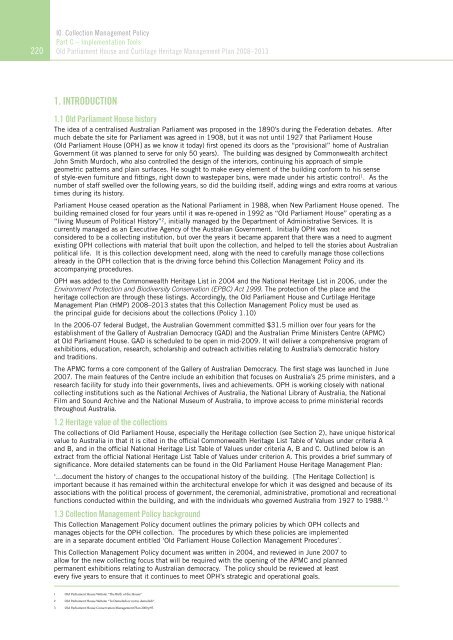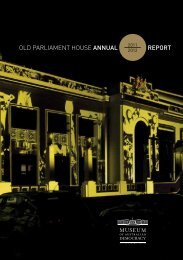OLD PARLIAMENT HOUSE AND CURTILAGE HERITAGE MANAGEMENT PLAN 2008–2013
Heritage Management Plan 2008-2013 - Museum of Australian ...
Heritage Management Plan 2008-2013 - Museum of Australian ...
- No tags were found...
You also want an ePaper? Increase the reach of your titles
YUMPU automatically turns print PDFs into web optimized ePapers that Google loves.
I0. Collection Management Policy<br />
Part C – Implementation Tools<br />
220 Old Parliament House and Curtilage Heritage Management Plan <strong>2008–2013</strong><br />
1. INTRODUCTION<br />
1.1 Old Parliament House history<br />
The idea of a centralised Australian Parliament was proposed in the 1890’s during the Federation debates. After<br />
much debate the site for Parliament was agreed in 1908, but it was not until 1927 that Parliament House<br />
(Old Parliament House [OPH] as we know it today) first opened its doors as the “provisional” home of Australian<br />
Government (it was planned to serve for only 50 years). The building was designed by Commonwealth architect<br />
John Smith Murdoch, who also controlled the design of the interiors, continuing his approach of simple<br />
geometric patterns and plain surfaces. He sought to make every element of the building conform to his sense<br />
of style-even furniture and fittings, right down to wastepaper bins, were made under his artistic control 1 . As the<br />
number of staff swelled over the following years, so did the building itself, adding wings and extra rooms at various<br />
times during its history.<br />
Parliament House ceased operation as the National Parliament in 1988, when New Parliament House opened. The<br />
building remained closed for four years until it was re-opened in 1992 as “Old Parliament House” operating as a<br />
“living Museum of Political History” 2 , initially managed by the Department of Administrative Services. It is<br />
currently managed as an Executive Agency of the Australian Government. Initially OPH was not<br />
considered to be a collecting institution, but over the years it became apparent that there was a need to augment<br />
existing OPH collections with material that built upon the collection, and helped to tell the stories about Australian<br />
political life. It is this collection development need, along with the need to carefully manage those collections<br />
already in the OPH collection that is the driving force behind this Collection Management Policy and its<br />
accompanying procedures.<br />
OPH was added to the Commonwealth Heritage List in 2004 and the National Heritage List in 2006, under the<br />
Environment Protection and Biodiversity Conservation (EPBC) Act 1999. The protection of the place and the<br />
heritage collection are through these listings. Accordingly, the Old Parliament House and Curtilage Heritage<br />
Management Plan (HMP) <strong>2008–2013</strong> states that this Collection Management Policy must be used as<br />
the principal guide for decisions about the collections (Policy 1.10)<br />
In the 2006-07 federal Budget, the Australian Government committed $31.5 million over four years for the<br />
establishment of the Gallery of Australian Democracy (GAD) and the Australian Prime Ministers Centre (APMC)<br />
at Old Parliament House. GAD is scheduled to be open in mid-2009. It will deliver a comprehensive program of<br />
exhibitions, education, research, scholarship and outreach activities relating to Australia’s democratic history<br />
and traditions.<br />
The APMC forms a core component of the Gallery of Australian Democracy. The first stage was launched in June<br />
2007. The main features of the Centre include an exhibition that focuses on Australia’s 25 prime ministers, and a<br />
research facility for study into their governments, lives and achievements. OPH is working closely with national<br />
collecting institutions such as the National Archives of Australia, the National Library of Australia, the National<br />
Film and Sound Archive and the National Museum of Australia, to improve access to prime ministerial records<br />
throughout Australia.<br />
1.2 Heritage value of the collections<br />
The collections of Old Parliament House, especially the Heritage collection (see Section 2), have unique historical<br />
value to Australia in that it is cited in the official Commonwealth Heritage List Table of Values under criteria A<br />
and B, and in the official National Heritage List Table of Values under criteria A, B and C. Outlined below is an<br />
extract from the official National Heritage List Table of Values under criterion A. This provides a brief summary of<br />
significance. More detailed statements can be found in the Old Parliament House Heritage Management Plan:<br />
‘...document the history of changes to the occupational history of the building. [The Heritage Collection] is<br />
important because it has remained within the architectural envelope for which it was designed and because of its<br />
associations with the political process of government, the ceremonial, administrative, promotional and recreational<br />
functions conducted within the building, and with the individuals who governed Australia from 1927 to 1988.’ 3<br />
1.3 Collection Management Policy background<br />
This Collection Management Policy document outlines the primary policies by which OPH collects and<br />
manages objects for the OPH collection. The procedures by which these policies are implemented<br />
are in a separate document entitled ‘Old Parliament House Collection Management Procedures’.<br />
This Collection Management Policy document was written in 2004, and reviewed in June 2007 to<br />
allow for the new collecting focus that will be required with the opening of the APMC and planned<br />
permanent exhibitions relating to Australian democracy. The policy should be reviewed at least<br />
every five years to ensure that it continues to meet OPH’s strategic and operational goals.<br />
1 Old Parliament House Website “The Birth of the House”<br />
2 Old Parliament House Website “To Demolish or not to demolish”<br />
3 Old Parliament House Conservation Management Plan 2000 p93




